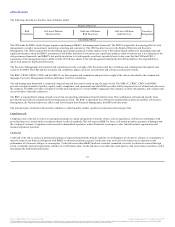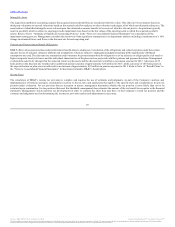BB&T 2014 Annual Report Download - page 76
Download and view the complete annual report
Please find page 76 of the 2014 BB&T annual report below. You can navigate through the pages in the report by either clicking on the pages listed below, or by using the keyword search tool below to find specific information within the annual report.
Table of Contents
BB&T monitors the ability to meet customer demand for funds under both normal and stressed market conditions. In considering its liquidity position,
management evaluates BB&T’s funding mix based on client core funding, client rate-sensitive funding and non-client rate-sensitive funding. In addition,
management also evaluates exposure to rate-sensitive funding sources that mature in one year or less. Management also measures liquidity needs against 30
days of stressed cash outflows for Branch Bank. To ensure a strong liquidity position, management maintains a liquid asset buffer of cash on hand and highly
liquid unpledged securities. The Company has established a policy that the liquid asset buffer would be a minimum of 5% of total assets, but intends to
maintain the ratio well in excess of this level. As of December 31, 2014 and December 31, 2013, BB&T’s liquid asset buffer was 13.6% and 14.6%,
respectively, of total assets.
During 2013, the FDIC, FRB and OCC released a joint statement providing a NPR concerning the U.S. implementation of the Basel III LCR rule. This rule
became final on September 3, 2014. Under the final rule, BB&T will be considered a “modified LCR” holding company. BB&T would be subject to full LCR
requirements if its operations were to fall under the “internationally active” rules, which would generally be triggered if BB&T’s assets were to increase
above $250 billion. BB&T implemented balance sheet changes to support its compliance with the rule and to optimize its balance sheet based on the final
rule. These actions included changing the mix of the investment portfolio to include more GNMA and U.S. Treasury securities, which qualify as Level 1
under the rule, and changing its deposit mix to increase retail and commercial deposits. Based on management’s interpretation of the final rule that will be
effective January 1, 2016, BB&T’s LCR was approximately 130% at December 31, 2014, compared to the regulatory minimum of 90%, which puts BB&T in
full compliance with the rule. The regulatory minimum will increase to 100% on January 1, 2017. The final rule requires each financial institution to have a
method for determining “operational deposits” as defined by the rule. The number above includes an estimate of operational deposits; however, BB&T
continues to evaluate its method to identify and measure operational deposits.
Parent Company
The purpose of the Parent Company is to serve as the primary capital financing vehicle for the operating subsidiaries. The assets of the Parent Company
primarily consist of cash on deposit with Branch Bank, equity investments in subsidiaries, advances to subsidiaries, accounts receivable from subsidiaries,
and other miscellaneous assets. The principal obligations of the Parent Company are principal and interest payments on long-term debt. The main sources of
funds for the Parent Company are dividends and management fees from subsidiaries, repayments of advances to subsidiaries, and proceeds from the issuance
of equity and long-term debt. The primary uses of funds by the Parent Company are for investments in subsidiaries, advances to subsidiaries, dividend
payments to common and preferred shareholders, retirement of common stock and interest and principal payments due on long-term debt.
The primary source of funds used for Parent Company cash requirements was dividends received from subsidiaries, which totaled $1.7 billion during 2014. In
addition, the Parent Company issued $2.6 billion of senior notes and repaid $1.5 billion of maturing long-term debt. Funds raised through master note
agreements with commercial clients are placed in a note receivable at Branch Bank primarily for its use in meeting short-term funding needs and, to a lesser
extent, to support the short-term temporary cash needs of the Parent Company. At December 31, 2013, master note balances totaled $24 million.
Liquidity at the Parent Company is more susceptible to market disruptions. BB&T prudently manages cash levels at the Parent Company to cover a minimum
of one year of projected contractual cash outflows which includes unfunded external commitments, debt service, preferred dividends and scheduled debt
maturities without the benefit of any new cash infusions. Generally, BB&T maintains a significant buffer above the projected one year of contractual cash
outflows. In determining the buffer, BB&T considers cash requirements for common and preferred dividends, unfunded commitments to affiliates, being a
source of strength to its banking subsidiaries and being able to withstand sustained market disruptions that could limit access to the capital markets. As of
December 31, 2014 and December 31, 2013, the Parent Company had 31 months and 27 months, respectively, of cash on hand to satisfy projected
contractual cash outflows as described above.
75
Source: BB&T CORP, 10-K, February 25, 2015 Powered by Morningstar® Document Research℠
The information contained herein may not be copied, adapted or distributed and is not warranted to be accurate, complete or timely. The user assumes all risks for any damages or losses arising from any use of this information,
except to the extent such damages or losses cannot be limited or excluded by applicable law. Past financial performance is no guarantee of future results.
























